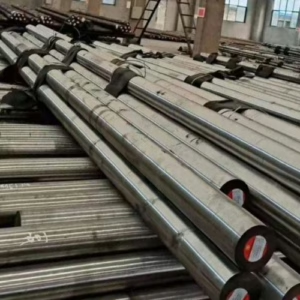7Cr7Mo3V2Si (LD) Cold Work Tool Steel
1. Overview and Key Advantages
7Cr7Mo3V2Si tool steel, often referred to as LD steel, is a high-performance cold-worked tool steel engineered for demanding applications. Its primary characteristics are high strength combined with excellent toughness, and it responds well to standard heat treatment processes.
Compared to other common tool steels, such as Cr12 grades or high-speed steels like W6Mo5Cr4V2, 7Cr7Mo3V2Si offers measurable improvements in strength, toughness, and wear resistance. This enhanced wear performance is primarily attributed to the formation of finely dispersed MC-type carbides within the steel’s microstructure following proper heat treatment. While its wear resistance meets or exceeds that of Cr12Mo1V1, 7Cr7Mo3V2Si provides significantly better toughness and resistance to softening at elevated temperatures (tempering resistance) than typical Cr12 series steels.
From a manufacturing standpoint, this grade exhibits good hot and cold workability. Importantly, it shows minimal distortion during heat treatment, ensuring dimensional stability for complex tooling.

2. 7Cr7Mo3V2Si tool steel Applications
The properties of 7Cr7Mo3V2Si make it highly suitable for cold-work tooling that must withstand significant operational stresses, including pressure and impact. Typical applications include:
- Cold heading tools: Punches and dies, including bolt trimming and piercing dies.
- Complex cold extrusion dies: Such as those used for manufacturing bicycle bottom brackets or similar components.
- Cold stamping and punching dies: Examples include tooling for automotive springs or silicon steel sheet lamination.
- Thread rolling dies: Especially for producing high-strength bolts.
- Other cold forming tools: Including cold forging, pressing, and bending dies.
This steel has proven its reliability in various sectors, including aerospace, automotive, bearing manufacturing, and general hardware production.
3. 7Cr7Mo3V2Si tool steel Chemical Composition
- Carbon (C): 0.70 – 0.80
- Silicon (Si):70 – 1.20
- Manganese (Mn):≤ 0.50
- Phosphorus (P):≤ 0.030
- Sulfur (S):≤ 0.030
- Chromium (Cr):50 – 7.50
- Molybdenum (Mo):00 – 3.00
- Vanadium (V):70 – 2.20
4. 7Cr7Mo3V2Si tool steel Technical Specifications
4.1 Heat Treatment Parameters
- Critical Temperatures: Ac1: 856°C, Ac3: 915°C, Ar1: 720°C, Ms: 105°C.
- Forging: Start forging between 1100-1150°C. Do not forge below 850°C. Ensure slow cooling after forging (below 700°C).
- Annealing: Heat to 840-860°C and hold for 3-4 hours. Furnace cool at a rate of 5-10°C per hour down to 600°C or lower, then air cool. Target annealed hardness is ≤187 HBW.
- Quenching: Austenitize at 1100-1160°C. Quench in oil.
- Tempering: Temper between 500 °C and 650°C, based on the required hardness. Typical resulting hardness ranges from 45 to 60 HRC.
4.2 Optimizing Properties via Heat Treatment
The final properties can be tailored through specific heat treatment choices:
- For High Strength and Toughness: Use a quenching temperature near the lower end of the range (approximately 1100°C), followed by tempering at around 550°C.
- For High Wear Resistance (especially under impact): Use a quenching temperature near the higher end (approx. 1150°C) followed by tempering around 560°C.
4.3 Advanced Processing for Enhanced Performance
For critical applications, consider these additional steps:
- Cryogenic Treatment: A deep freeze at -196°C for 1 hour, applied after quenching and before tempering, can sometimes extend tool life, particularly in stainless steel cold extrusion dies.
- Surface Treatments: Processes like nitrocarburizing (performed at around 550°C after quenching and tempering) have demonstrated significant life improvements for components such as high-speed punches for aluminum tubes.
5. Proven Performance
Field results confirm the advantages of 7Cr7Mo3V2Si. Examples include:
- Rolling dies show double the lifespan of Cr12MoV dies and four times that of 9SiCr dies.
- Cold extrusion punches achieved 6-7 times the service life compared to conventional heat treatment methods when an optimized low-temperature quench and temper cycle was employed.
6. Important Processing Note
Exercise caution during the quenching step. Heating above the recommended maximum of 1160°C can lead to overheating, resulting in excessive grain growth, which negatively impacts the steel’s properties.
7. Summary
7Cr7Mo3V2Si (LD) tool steel offers a robust combination of strength, toughness, and wear resistance, making it suitable for a wide range of demanding cold work applications. Its performance advantages are realized through careful control of heat treatment and processing. This grade represents a reliable material choice for complex tooling where longevity and performance under pressure are critical.
Explore Our Other Products
D2/1.2379/SKD11
D3/1.2080/SKD1
D6/1.2436/SKD2
A2/1.23663/SKD12
O1/1.2510/SKS3
O2/1.2842
S1/1.2550
S7/1.2355
DC53
H13/1.2344/SKD61
H11/1.2343/SKD6
H21/1.2581/SKD7
L6/1.2714/SKT4
M2/1.3343/SKH51
M35/1.3243/SKH55
M42/1.3247/SKH59
P20/1.2311
P20+Ni/1.2738
420/1.2083/2Cr13
422 stainless steel
52100 bearing steel
440C stainless steel
4140/42CrMo4/SCM440
4340/34CrNiMo6/1.6582
4130
5140/42Cr4/SCR440
SCM415
🔥 Special Offer for 7Cr7Mo3V2Si Tool Steel Inquiries 🔥
Looking for a reliable 7Cr7Mo3V2Si supplier? Get more than just a quote!
✅ Free Metallurgical Consultation – Get expert advice on grade comparison, machining, and heat treatment.
✅ Mill Test Certificate Guaranteed – 100% traceability with every shipment.
✅ Fast Quote in 12 Hours – Get pricing, stock info, and delivery time within 1 working day.
✅ Trial Order Support – Flexible MOQ for new customers.
